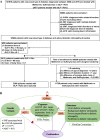Glucagon-like peptide-1 receptor agonists and diabetic retinopathy: nationwide cohort and Mendelian randomization studies
- PMID: 36737746
- PMCID: PMC9898966
- DOI: 10.1186/s12916-023-02753-6
Glucagon-like peptide-1 receptor agonists and diabetic retinopathy: nationwide cohort and Mendelian randomization studies
Abstract
Background: The ability of glucagon-like peptide-1 receptor agonists (GLP-1 RAs) to decrease certain microvascular events has called for the investigation of GLP-1 RAs against diabetic retinopathy (DR), but the evidence is limited. By combining data from observational and Mendelian randomization (MR) studies, we aimed to investigate whether GLP-1 RAs decrease the risk of DR.
Methods: We combined data from several Swedish Registers and identified patients with incident type 2 diabetes being treated with GLP-1 RAs between 2006 and 2015, and matched them to diabetic patients who did not use GLP-1 RAs as the comparisons. The Cox proportional hazards models were applied to assess the risk of DR. We further performed the summary-data-based MR (SMR) analyses based on the Genotype-Tissue Expression databases and the Genome-Wide Association Study of DR from the FinnGen consortium.
Results: A total of 2390 diabetic patients were treated with GLP-1 RAs and the incidence of DR was 5.97 per 1000 person-years. Compared with diabetic patients who did not use GLP-1 RAs having an incidence of 12.85 per 1000 person-years, the adjusted hazard ratio (HR) of DR was 0.42 [95% confidence interval (CI), 0.29-0.61]. Genetically-predicted GLP1R expression (the target of GLP-1 RAs) showed an inverse association with background [odds ratio (OR)=0.83, 95% CI, 0.71-0.97] and severe nonproliferative DR (OR=0.72, 95% CI, 0.53-0.98), and a non-significant association with overall (OR=0.97, 95% CI, 0.92-1.03) and proliferative DR (OR=0.98, 95% CI, 0.91-1.05).
Conclusions: Both observational and mendelian randomization analyses showed a significantly lower risk of DR for patients treated with GLP-1 RAs, which calls for further studies to validate these findings.
Keywords: Cohort study; Diabetic retinopathy; GLP-1 RAs; Mendelian randomization.
© 2023. The Author(s).
Conflict of interest statement
The authors declare that they have no competing interests.
Figures



References
Publication types
MeSH terms
Substances
LinkOut - more resources
Full Text Sources
Medical

